Cilantro can be a fairly divisive herb. Some people are absolutely in love with the flavor, others can’t stand it and say it tastes like soap.
We obviously fall into the former camp and grow a lot of it every year! It is always one of our favorites and not a year goes by that we don’t grow it.

Cilantro and coriander generally prefer cooler summers, so they are an excellent candidate for growing in northern climates.
These are our top tricks and tricks to getting both cilantro and coriander to grow in the far north!
Cilantro Is Coriander, Coriander Is Cilantro
Just in case you didn’t know, we should cover the most basic thing. Cilantro and coriander are the same plant.
Cilantro is typically the younger plant, specifically when you harvest the leaves and stems. It is commonly harvested prior to flowering for best results.
Coriander, on the other hand, are the seeds of the cilantro plant. Once the plant has had a chance to flower, the seed pods can be harvested as coriander.
In this respect, the cilantro plant can be considered both an herb (cilantro) and a spice (coriander). Both are excellent contributions to the northern garden!
Cilantro and Coriander Are Challenging In The Subarctic
We have run into some significant challenges, particularly with growing cilantro in the far north.
We observed that our plants would commonly flower very early in the season, even when using reliable slow-bolt varieties that had performed well for us in the past. (But, notably, at lower latitudes.)
Unfortunately, we haven’t been able to prove, scientifically, that cilantro is a plant that is considered to have long day photoperiodism. Based on our results, though, we’d suspect that it is.
On the coriander side, some varieties require longer growing times than our short growing season permits. Many varieties, though, can produce coriander in about 90 to 110 days.
What this means, though, is that we have to take a bit of care to select particular cilantro genetics to get the results we desire.
We’ve also found it best to pursue either cilantro or coriander. But not both from the same plant and genetics! We’ll touch more on this a bit later.
The Best Northern Cilantro Variety
We had to trial a lot of different cilantro varieties to find one that was particularly resistant to bolting under the midnight sun.
Most common slow-bolt cilantro varieties will start flowering within mere weeks of transplanting outdoors.
Ideally, what we want is a cilantro plant that primarily produces the leaves and stems throughout most of the growing season. This allows more continual harvesting, an ideal approach for most fresh herbs.
In our trials, we discovered that the Calypso variety was the most bolt resistant to our northern conditions. Literally no other variety we tried worked nearly as well.
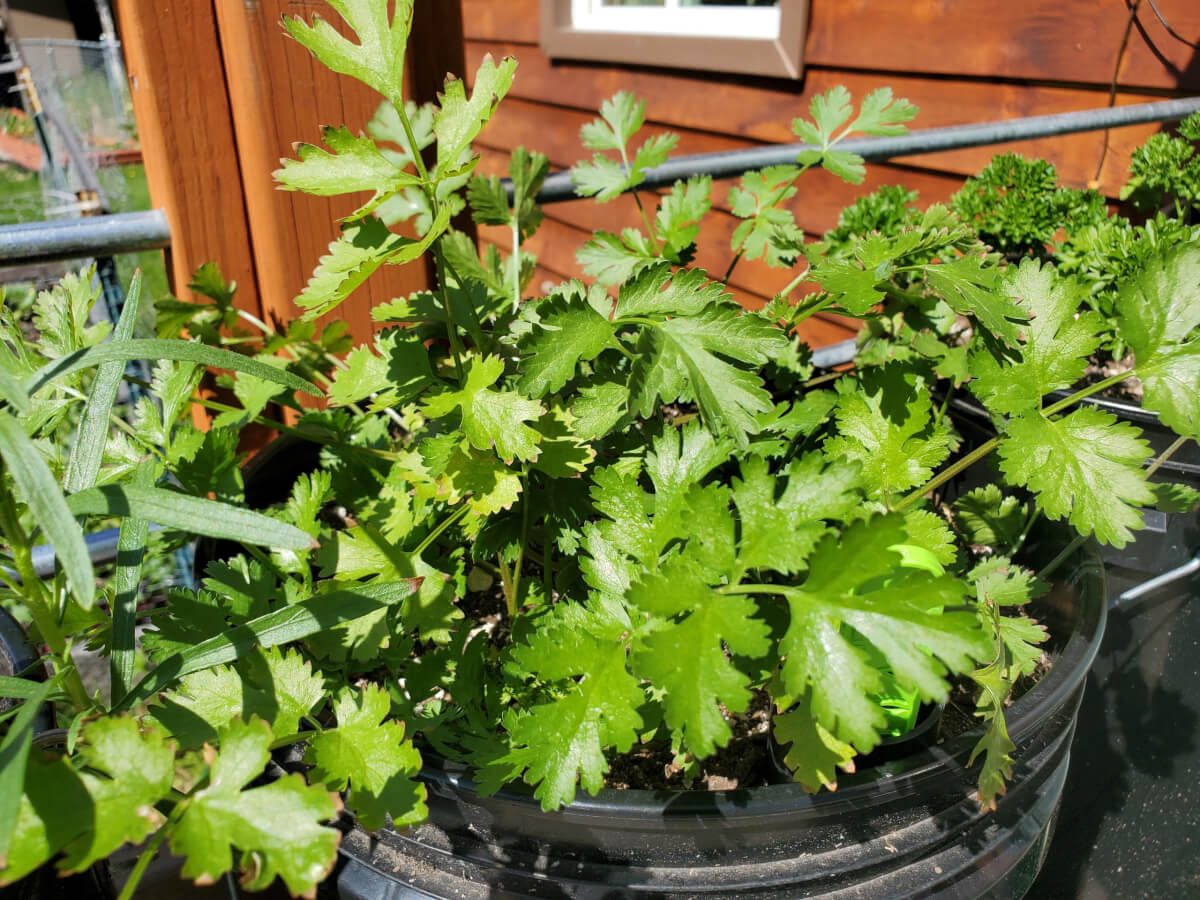
This is Calypso cilantro, growing over the subarctic summer. Approximately two to three weeks after transplanting outdoors.
This variety can grow rather strangely, at least compared to most cilantro. Instead of producing tall, leafy stems, it tends to be more compact with a cratered center where the flowers would typically emerge. There’s some funky genetics going on, but it works!
In general, we’ve found it to produce quality cilantro through about 75% of our entire growing season.
It produces coriander, too, but we’ve found that to require 130+ days with the Calypso variety. That’s a bit longer than we have in our short, subarctic growing season of 110 days max!
We can sometimes get Calypso to work in a long, Indian summer season, but this is not always reliable. For this reason, if we truly want coriander, we have to treat it a bit differently.
Successful Coriander In The Subarctic
Since our preferred cilantro variety is unlikely to produce coriander in our short growing season reliably, it’s desirable to grow a different variety of cilantro for coriander production.
We’ve found pretty much any other cilantro variety, other than Calypso, has a fairly decent opportunity to grow into coriander. Even so called “slow-bolt” varieties. (Again, we think cilantro is long day photoperiodism sensitive.)
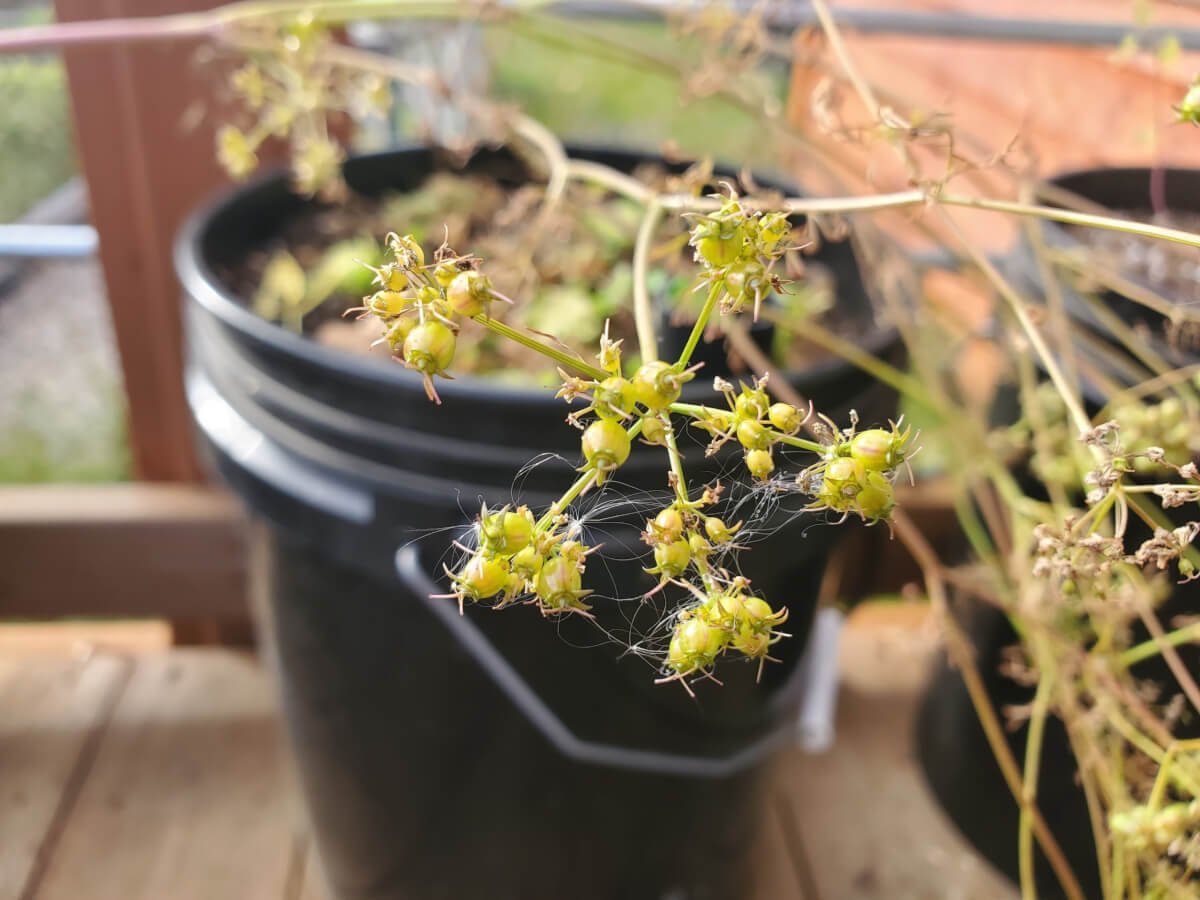
Most types of cilantro will produce mature coriander in around 90 to 110 days from the time you transplant outdoors.
There are also some specialized coriander seeds, which are primarily aimed at coriander production. These are even better, since they will flower with more urgency earlier in the season.
You can still harvest these plants for cilantro, but you generally want to reduce your harvests and allow the plant to flower.
Growing Cilantro And Coriander From Seed
Now that we’ve got our general cilantro and coriander strategy out of the way, let’s get into the specifics of growing them!
In the north, a good target time to sow your cilantro is 6 to 7 weeks before last frost.
There can be some variability to this, should you so desire. If you desire coriander, sowing 7 to 8 weeks before last frost is will ensure coriander production. If you want to target all-season cilantro production, 5 to 6 weeks before last frost will work as well.
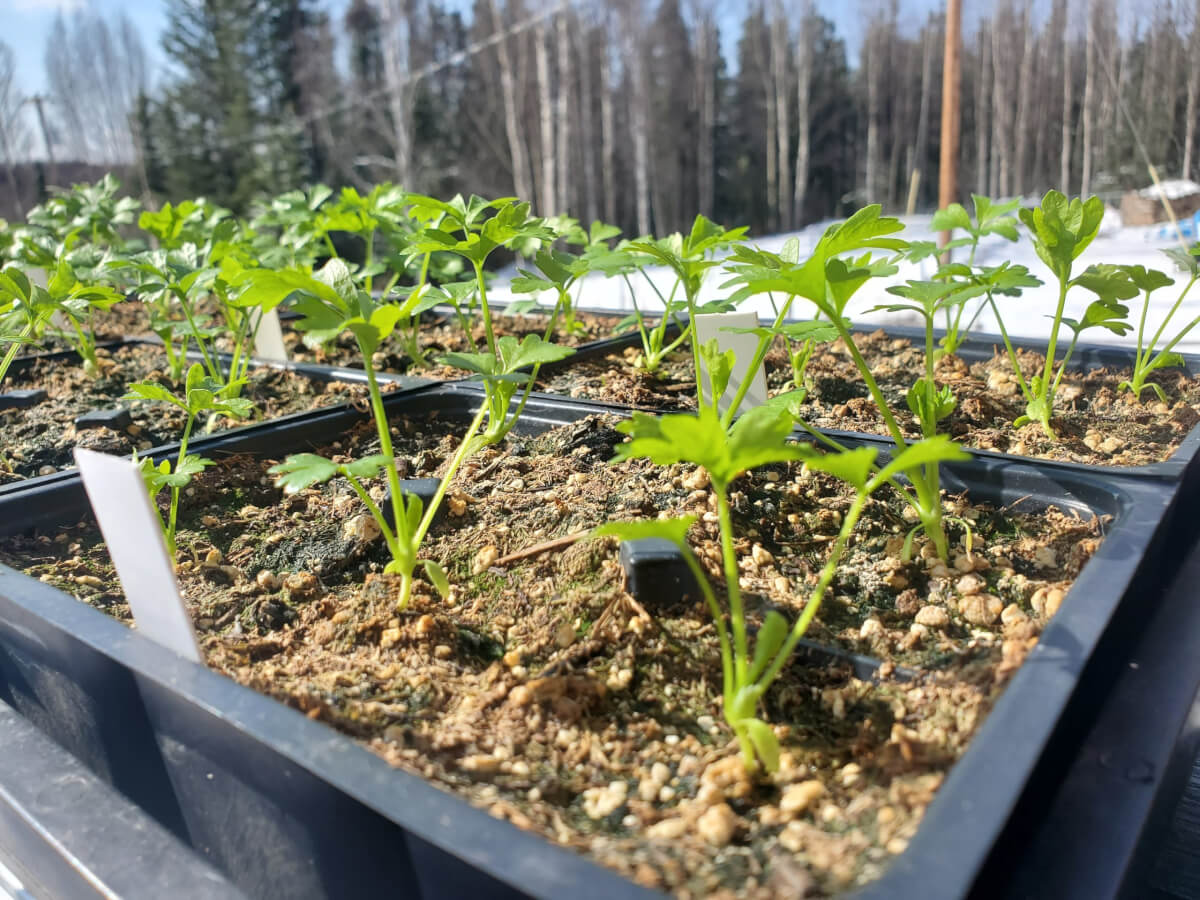
Some people prefer to soak their cilantro seeds for about 24 hours prior to sowing. We don’t do this and have no major issues with germination. We do suggest warmer soils for germination, typically above 65 degrees is best.
We like to start ours in a seedling tray using high quality, reasonably sterile potting mix. Transplant to a larger container a little bit after you see the first true leaves.
Transplant into your garden after danger of frost has passed. We strongly suggest after last frost as cilantro is frost sensitive.
Growing Cilantro & Coriander In Your Garden
Cilantro generally prefers warmer soils, so we would suggest not growing it in the ground in northern climates. We discuss the details on “why” more extensively here.
Raised beds and containers will perform the best in northern climates. We use containers (our sub irrigated buckets) and get amazing success.
Cilantro handles intensive planting rather well. We generally plant four cilantro plants in a given five gallon bucket. This would translate to about four per square foot if using square foot gardening.
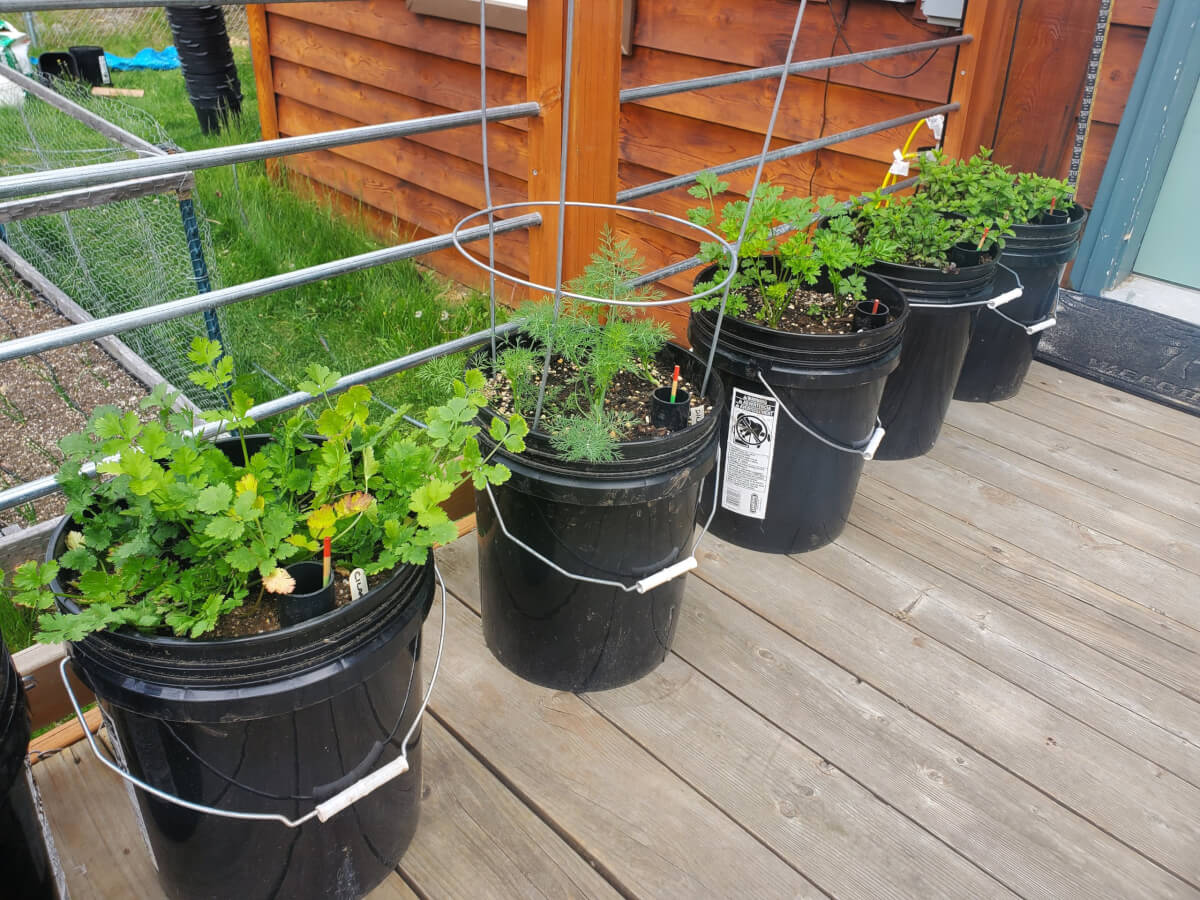
(Left) Cilantro. We grow most of our herbs quite intensively, allowing us to maximize production in a relatively small space.
Using this method, we get big, bushy growth of cilantro. Plenty to harvest for summer and preserve some through drying or freezing, if we like. We cover preservation later in this article.
Ideal soil will be well draining and nutrient rich. It should clump together, but also break apart quite easily when lightly crushed.
If you can harvest your cilantro frequently, do so. This helps with delaying the plant going to seed. If you’re entirely cilantro focused, cut off any flowers as they develop.
When we grow for coriander, we generally keep these plants separate from our cilantro production. We also tend to harvest very little cilantro from these plants, allowing the plant to just do its thing.
Growing, Harvesting & Preparing Coriander
When you’re growing for coriander, generally you want to allow the plant to mature the entire season. Or about 90-110 days, whichever comes first.
Your cilantro plant should be looking pretty rough at the end of the season. A bit of brown, with big seed pods developed where the former flowers were.
Prior to harvesting, check your plant and the seed pods for aphids. If you see any, there will be an additional step.

This is coriander getting quite near to harvest time. The seed pods should largely be brown, along with the rest of the plant.
To harvest your coriander, simply cut off the plants seed pods. You’ll need to dry out those seeds!
If you saw any aphids in the above step, you probably want to dry them outdoors prior to bringing them inside. This will prevent an aphid infestation from getting into your house.
To dry them, a good technique is to place them in a paper bag. This will help absorb moisture. Hang the bag (indoors or outdoors) somewhere and let them sit for awhile. Check them every few days.
You should see the coriander start to fall off the flowering seed pods. Once they are fully dry and have fallen off the flower, they should be good.
Preserving Cilantro & Coriander For The Long Haul
Coriander should be stored in an air tight glass jar, if possible. This will ensure long shelf life.
If you notice any moisture develop in the jar, the seeds were not yet dry in the previous steps. Be sure to allow them to continue drying before long term storage!
For cilantro, we definitely encourage harvesting and using as much as you can fresh!
We do have a couple of preferred preservation techniques for longer term storage, though!
Cilantro will take decently well to freezing. You can simply place the destemmed, washed and dried cilantro in a freezer rated ziplock bag and freeze it.
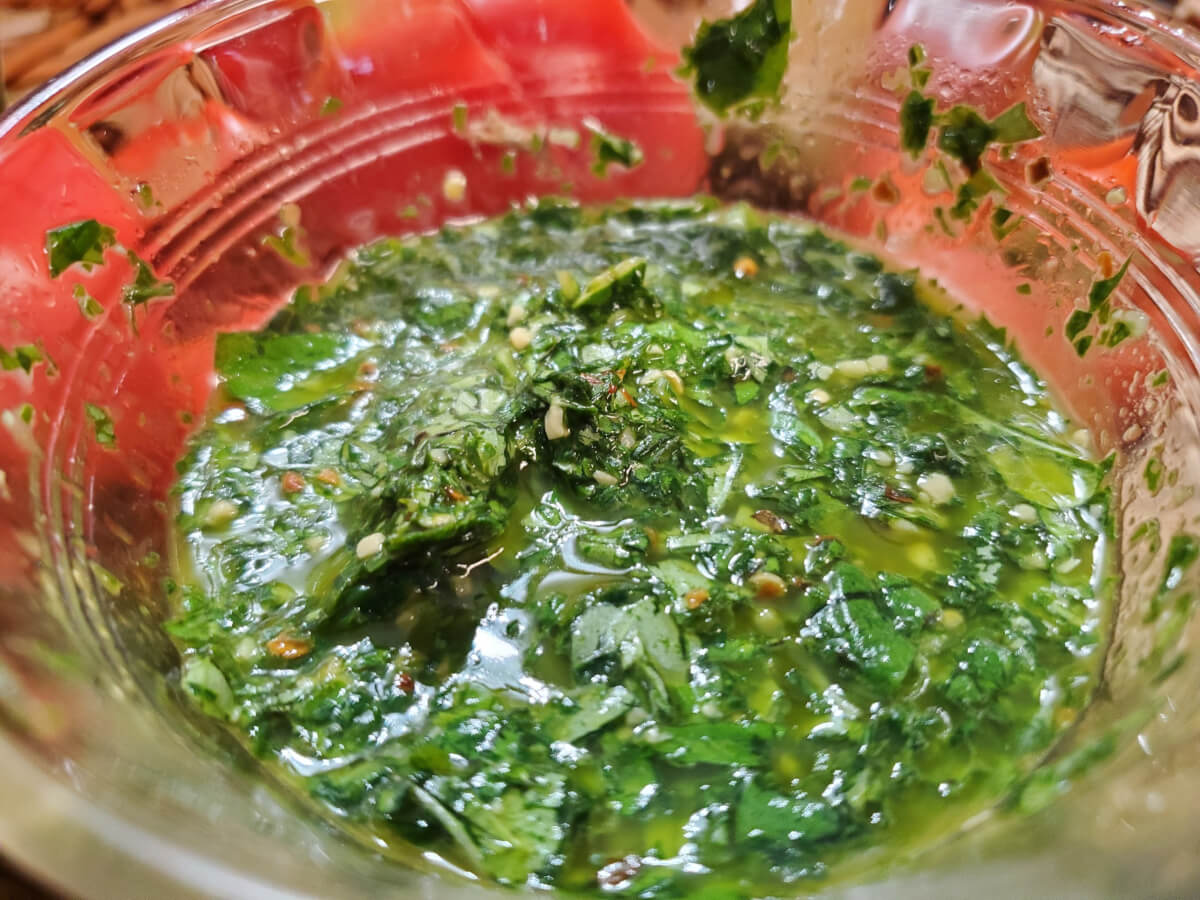
This is our more preferred way of preserving cilantro. We typically make blended oils and freeze them into ice cube trays. Recipes below!
Cilantro can also be dried. We suggest hanging your plants upside down in an area with good air circulation and little light exposure. Keep them hanging until fully dried. Crush and store in an air tight glass jar.
Our more preferred method is to make herb infused ice cubes. These can be tossed into dishes for a fantastic fresh garden flavor over the winter. Here’s a few ideas:
- Straight Cilantro: 1/2 cup cilantro, blended with water to make a puree. Freeze into ice cube trays, store in a freezer bag.
- Basic Cilantro Oil: 1/2 cup cilantro + 1/4 cup olive oil + 1tbps water, well blended. Freeze into ice cube trays, store in a freezer bag.
- Garlic Cilantro Oil: 1/2 cup cilantro + 1/4 cup olive oil + 1tbps water + 1-2 diced garlic cloves, well blended. Freeze into ice cube trays, store in a freezer bag.
- Spicy Cilantro Oil: 1/2 cup cilantro + 1/4 cup olive oil + 1tbps water + 1-2 diced garlic cloves + 1/2tsp red pepper flakes, well blended. Freeze into ice cube trays, store in a freezer bag.
- Cilantro Pesto: You can substitute cilantro for basil in typical pesto recipes. We freeze into ice cube trays and store in a freezer bag.
Cilantro & Coriander In A Nutshell!
That’s pretty much all there is to it! We love our fresh and preserved cilantro/coriander harvests!
They are definitely one of our favorite herbs/spices to use in our kitchen. A homegrown harvest is a valuable addition to the northern garden.
As always, if you have any comments, thoughts, ideas or anything else to add, we encourage you to slap a comment down below!
That’s All We Wrote!

Having a good time? We have an ever growing list of insightful and helpful subarctic & cold climate gardening articles, waiting out there for you!
- Cold Climate Gardening Basics 👉
- Growing Your Garden From Seed Indoors 👉
- Advanced Cold Climate Gardening Techniques 👉
- Plant Specific Cold Climate Growing Guides 👉
- Subarctic Perennial Food Forests & Foraging 👉
- Indoor Garden Lighting & Grow Rooms 👉
- Greenhouses & Temperature Control 👉
- Harvesting & Food Preservation 👉
- Solving Cold Climate Garden Problems 👉
- 1 Minute Reads On Tons Of Garden Topics 👉
FrostyGarden.com is 100% ad-free and we do not use affiliate links! This resource is voluntarily supported by our readers. (Like YOU!) If we provided you value, would you consider supporting us?
